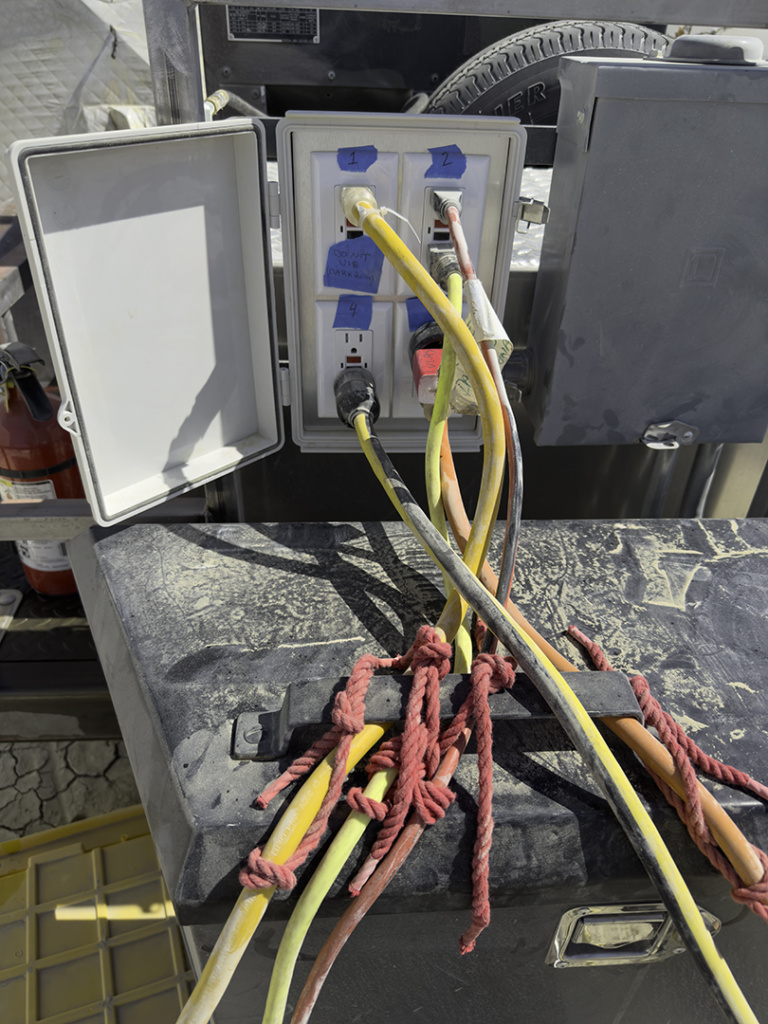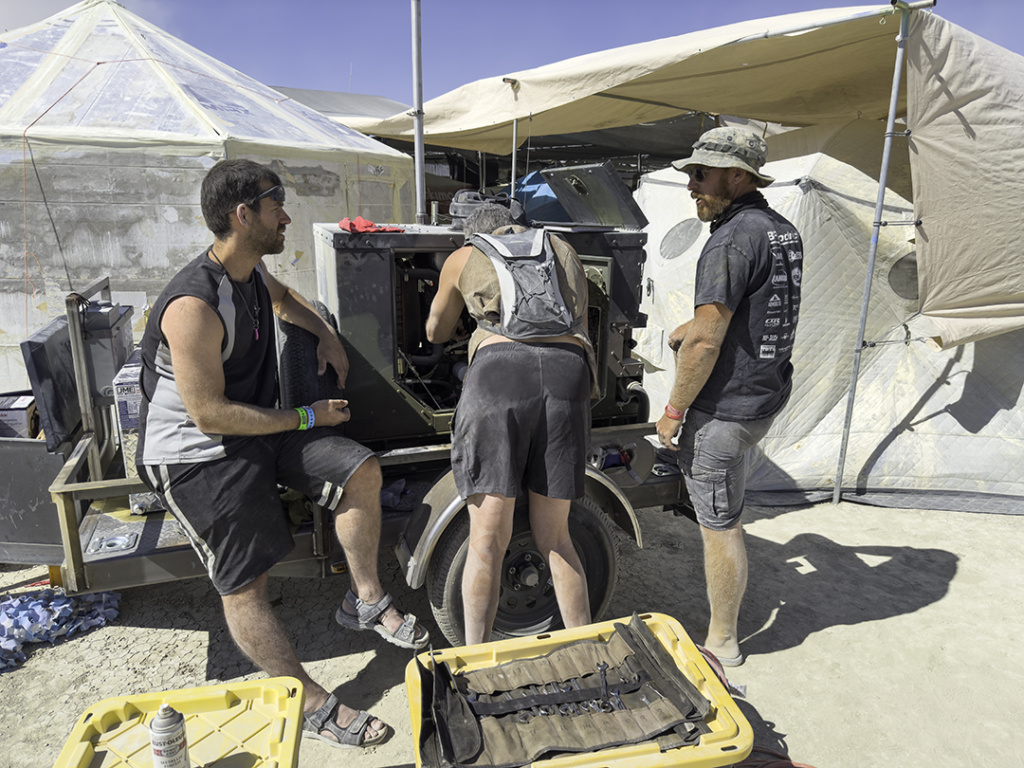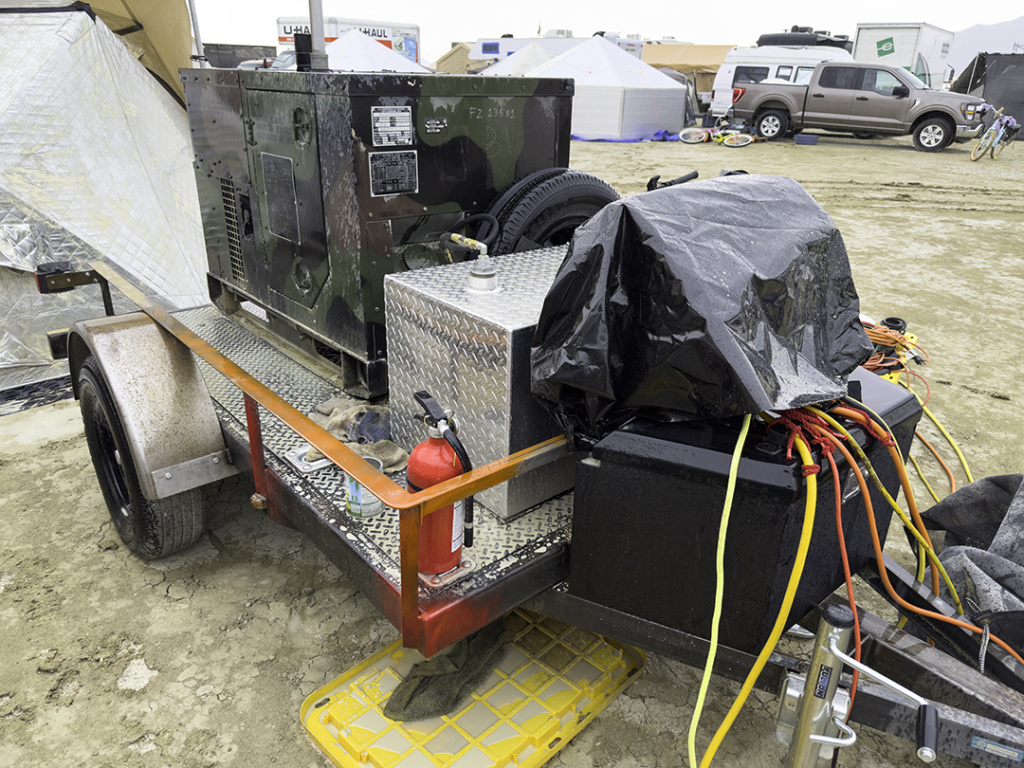
This is the final chapter of a five-chapter story about designing and building a trailer to carry a military surplus generator for our camp at Burning Man. To read the previous chapter, click here.
Armed with my Work Pass, a permit to enter the Burning Man Playa before the event opens, I drove 554 miles from my home to our camp – The Pinhole Project – at Burning Man. I did this over two days to make it easier on myself. I stopped for the night in Boomtown, on the western edge of Reno, and got up early the next day to complete my journey.
I had driven from home to Reno with the generator’s auxiliary tank empty. I did this to save money –diesel fuel is cheaper in Nevada than in California, and to save fuel – 50 gallons of diesel weighs about 350 lbs. and I didn’t want to pull that weight any further than necessary. So I filled all tanks in Sparks, on the eastern edge of the valley, then set off for the Black Rock desert, a hundred miles northeast of Reno.
I arrived before noon, and found my camp-mates had erected the shade structure, assembled the kitchen area, and set up the darkroom in our container cargo box. This container belongs to us, and we pay the Burning Man organization to store it out there, and to deliver it to our camp location before the event begins. This allows us to leave all the physical equipment in the desert, and not carry it back and forth to the cities where we live.
We positioned the generator in the camp according to a plan we had made weeks before, and we ran cords to it for the darkroom, the kitchen, and a couple of air conditioners. I started it up and it began to send power to all of those things. It worked perfectly.

The generator features a tongue box that I bought from Harbor Freight. That holds a number of important items: extra oil, coolant, a fuel filter, and oil filter, a new V-belt and the tools needed to change those things. I also put a set of socket wrenches in there, and an extra hub in case one of the two on the trailer failed. I tried to cover for any possible failure, and also for routine maintenance.
We ran the generator Friday, Saturday, Sunday, and Monday morning.
Then it sputtered to a stop.
Which was entirely my fault. I had set the machine to run from the internal fuel tank. It simply ran out of fuel. And, when it did, I switched it to the auxiliary tank and tried to start it again. But it refused. I got out the manual and followed the troubleshooting recommendations there. I changed the fuel filter; I checked (but did not change) the air filter; I checked the oil level. It was low.
So I added some oil. I kept adding oil until the dipstick showed a normal oil level. When I got that reading, I stopped putting oil into the engine block.
Then I cranked it over and over and it would not start. The engine was fighting to run, making puffs of white smoke. But it would not start. I started thinking about Plan B. That plan was to hitch it back on my van and drive it to Reno to search for a diesel mechanic. I knew this would be an awful trip because I didn’t know where to take it, and I had no idea if I could get it repaired.
My camp-mates assured me the we could find someone locally to help. The Playa Provides! they told me. We sent two emissaries out to get help. One went to a nearby camp where live music is performed, one that had several diesel generators, and therefore must have a mechanic. The other went to the Info office at Center Camp. There, she was given an address for a camp that specializes in fixing things.
And… the Playa provided! Within a couple of hours we had not one, but three diesel mechanics! One approached the generator (officially known by the military as an MEP 802a Quiet Generator) and said, “I know this generator! I’ve installed three of these!” I was relieved. They prodded and tested; they opened connectors and fittings, and they determined that one cylinder was not firing. So, they disassembled that cylinder’s injector, and determined that it was OK. But there was oil in the cylinder! I had put too much into the engine, and some of it got into the cylinder somehow.

One of these clever men fashioned a Gatorade bottle with two tubes coming out the top (made from a ballpoint pen body). On one tube they put a rubber hose – borrowed from the fuel filter/water separator – and proceeded to suck the oil out of the cylinder into the bottle. It was a brilliant solution to the problem.
Once the oil was purged, the injector was reinstalled and we cranked the engine. It started. At first it was unsteady, but within a few seconds, the roughness smoothed out and it began to purr. We switched the fuel supply to the auxiliary tank, and the generator then ran for another week without trouble.
It was entirely my fault from beginning to end. I thought I was doing the right thing, but I overdid it. I put too much oil in the crankcase.
My three new best friends slapped me on the back, organized their tools, and returned to their camps to fix other people’s machines. We moved on with our purring generator for the duration of the event.
You might have seen on the news that Burning Man turned into a mess this year. On Friday afternoon it rained, and then it rained more on Saturday. The Playa, or lake bed, of the Black Rock Desert is made of a very fine silt that is the texture of talcum powder. That, mixed with about an inch of rain, turned the Playa into a lake of mud. It had the consistency of grease, and that made life there unpleasant. Contrary to some of the sensational headlines, most of us figured out how to maneuver in the mud, and we went on with our lives. We didn’t try to go anywhere, as that was impractical, but we had meals, we gathered with our friends, and we remained happy and healthy until we were finally allowed to leave the Playa on Monday. By then, the greasy mud had dried to a firm, damp surface.

I hitched the trailer to my van on Tuesday morning, and I drove – very slowly – out to the paved road and then homeward, stopping again in Boomtown for the night before driving back to San Luis Obispo on Wednesday.
The generator is here now, resting on private property until next time I need it. I took it to the car wash yesterday and cleaned it thoroughly before storing it.

Hi Brian,
When I read about the Gatorade bottle and the two tubes used to remove the excess oil, I remembered the DeLee mucus trap we’d always have available at every C-Section birth. One of the tubes was small enough to fit down a newborn’s nose and mouth so that excess fluid can be removed. Infants born traditionally usually have the mucus squeezed out of them as they enter the world, but infants born via C-Section can be goopy. There are even smaller mucus traps for newborn animals.